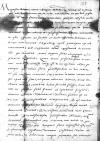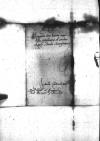Quod rarius ad te scribo, quam vel benevolentia
in te mea, vel merita in me tua postulant, in causa sunt occupationes meae, quibus, ut scis, noctes diesque distineor, sed praecipue tabellariorum inopia, quorum pauci admodum idque raro se offerunt, qui in hunc extremum orbem, ubi tu es, proficiscantur. Doleo vehementer te istic aegrum, ut scribis, et male affectum detineri et ob eam rem accurate diligenterque apud ⌊principem⌋ egi, ut revocaveris, sed ⌊reginalis maiestas⌋ existimat te unum esse, qui ⌊ducatus Barensis⌋ negotio solus, aliquando colophonem im stain⌈[m]m stain⌉ponas. Quare donec perfectis superinscribed, in the hand of sender⌈perfectisperfectis superinscribed, in the hand of sender⌉ rebus istinc te revocari non vul stain⌈[vul]vul stain⌉t, necesse itaque est te hoc exilium adhuc parumper aequo animo ferre, quandoquidem in hoc laboro, ut quam occissime revoceris, ut autem interim earum rerum, quae apud nos sunt, aliquam notitiam habeas, scias hactenus nos ab omnibus bellis feriatos fuisse. Nam collocato in ⌊Podolia⌋ satis firmo ex equitibus praesidio domino ⌊comite Tharnoviensi⌋ ductore, factum est, ut ⌊Tartari⌋ ab incursionibus temperarunt. Post mortem domini ⌊R stain⌈[R]R stain⌉aphaelis, Plocensis episcopi⌋, nepos meus dominus ⌊Cricius⌋ Plocensem, dominus vero ⌊Carnkowski⌋ Premisliensem pontificatum obtinuit. Serenissimus dominus ⌊Ferdinandus⌋, rex ⌊Bohemiae⌋, cum valido ex Germanis exercitu iam ⌊Hungariae⌋ fines ingressus est, ⌊arcem Posoniensem⌋, oppidum Ternawa, castellum Teben et Iaurinum in deditionem accepit, promittit sibi universum  AAWO, AB, D. 66, f. 151v ⌊regnum Hungariae⌋, quamvis ⌊rex Ioannes⌋, qui ex comite Scepusiensi diadema regni adeptus est, resistit. Quis eius belli exitus futurus est, Deus novit. Serenissimus dominus ⌊noster rex⌋, tametsi, ut scrip stain⌈[scrip]scrip stain⌉si, in ⌊Podolia⌋ praesidium ha stain⌈[praesidium ha]praesidium ha stain⌉beat, tamen veretur, ne ⌊Thartari⌋ adeo magnis viribus terras eius aggrediantur, quibus praesidium ipsum se opponere non valeret. Igitur ad quoscumque subitos casus iussit omnibus subiectis suis in armis esse, ⌊ipse⌋ quoque quocumque impetus et necessitas vocaverit paratus exspectat, his et aliis magnis et arduis domesticis rebus occupatus, neutri regum adhaerens, ad tuendum hidden by binding⌈[um]um hidden by binding⌉ dumtaxat sua intentus est, nec se exter paper damaged⌈[ter]ter paper damaged⌉nis bellis immiscere vult, quamvis magnis precibus et pol paper damaged⌈[ol]ol paper damaged⌉licitationibus utrimque hidden by binding⌈[ue]ue hidden by binding⌉ sollicitatus.
AAWO, AB, D. 66, f. 151v ⌊regnum Hungariae⌋, quamvis ⌊rex Ioannes⌋, qui ex comite Scepusiensi diadema regni adeptus est, resistit. Quis eius belli exitus futurus est, Deus novit. Serenissimus dominus ⌊noster rex⌋, tametsi, ut scrip stain⌈[scrip]scrip stain⌉si, in ⌊Podolia⌋ praesidium ha stain⌈[praesidium ha]praesidium ha stain⌉beat, tamen veretur, ne ⌊Thartari⌋ adeo magnis viribus terras eius aggrediantur, quibus praesidium ipsum se opponere non valeret. Igitur ad quoscumque subitos casus iussit omnibus subiectis suis in armis esse, ⌊ipse⌋ quoque quocumque impetus et necessitas vocaverit paratus exspectat, his et aliis magnis et arduis domesticis rebus occupatus, neutri regum adhaerens, ad tuendum hidden by binding⌈[um]um hidden by binding⌉ dumtaxat sua intentus est, nec se exter paper damaged⌈[ter]ter paper damaged⌉nis bellis immiscere vult, quamvis magnis precibus et pol paper damaged⌈[ol]ol paper damaged⌉licitationibus utrimque hidden by binding⌈[ue]ue hidden by binding⌉ sollicitatus.
Habeo tibi gratias, quod consilia medicorum istius curiae descripta ad levandum oculorum dolorem mihi miseris. Non sum eis hactenus usus, eo quod Deo hidden by binding⌈[o]o hidden by binding⌉ favente languor ille pristinus abiit et oculis gratia Deo tam valeo, ut medicaminibus opus non sit. Tamen officium hoc tuum et de mea valetudine sollicitudo mihi apprime grata est, quam tibi omni amicitia et gratificatione mea referre curabo. Vale.
 AAWO, AB, D. 66, f. 1v unnumbered after f. 151
AAWO, AB, D. 66, f. 1v unnumbered after f. 151
 AAWO, AB, D. 66, f. 151v
AAWO, AB, D. 66, f. 151v 

